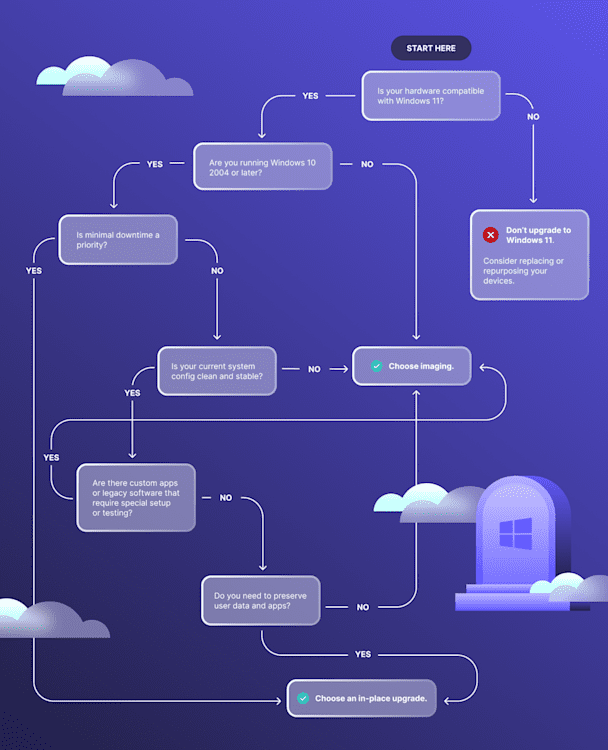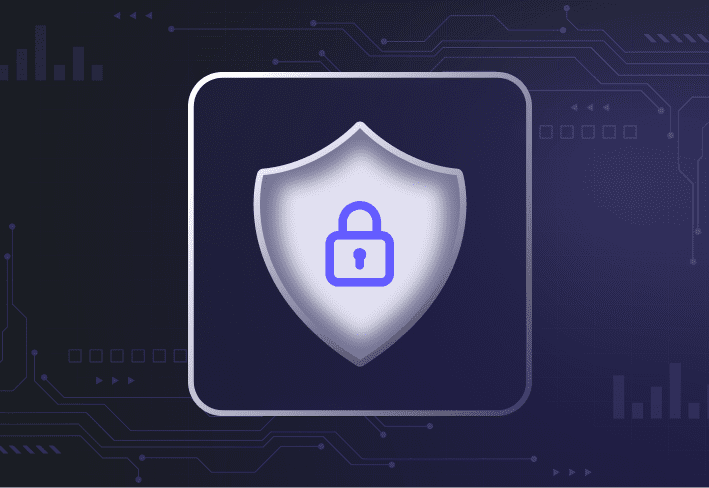With Microsoft’s decision to officially retire Windows 10 on October 14, 2025, we face a few complicated questions. Do we cling to Windows 10 and invest in Extended Security Updates (ESUs)? Do we roll out Windows 11 — and if so, what does a good Windows migration plan look like? Should we rely on computer imaging or in-place upgrades to get the job done?
This blog helps you choose between in-place upgrades and computer imaging.
Planning your Windows 11 migration?
Don't let the Windows 10 end of life catch you with your backups down — or your endpoints exposed. We've got tools, step-by-step guides, and a whole Discord channel with fellow sysadmins to help you upgrade without losing your cool (or your configs). Visit our Windows 10 End of Life Hub.
What is an in-place upgrade?
An in-place upgrade is the process of installing a newer version of an operating system directly over the existing version without removing apps, settings, or user data. This method reduces deployment time and preserves system configurations, making it ideal if you need to upgrade your systems quickly and with minimal disruptions.
Considering an in-place upgrade?
Learn how to perform an in-place upgrade to Windows 11 manually, with PDQ Connect, or with SmartDeploy.
What is computer imaging?
Computer imaging is the process of creating a standardized copy (image) of a computer’s operating system, software, and configurations, which you can then deploy to multiple machines. Computer imaging overwrites user data, replacing it with a consistent image (or a golden image) for each device in your environment.
Considering reimaging your devices?
Learn how to move your fleet from Windows 10 to Windows 11 via reimaging.
In-place upgrades vs. imaging: Which should you choose?
So, you’ve made the decision to upgrade to Windows 11. Which is better: an in-place upgrade or imaging? Of course, the answer is ... it depends.
At the risk of oversimplifying, here are two quick considerations to help you decide if an in-place upgrade or imaging best suits your needs:
Need speed? Choose an in-place upgrade. It’s faster and keeps user data and apps intact (but runs the risk of carrying over old clutter, misconfigurations, malware, etc.).
Want a clean slate? Choose imaging. It takes longer, but it wipes everything from your machine and gives you a fresh, controlled install of your operating system.
When to choose an in-place upgrade to migrate to Windows 11
In-place upgrades may be the best solution for your Windows 11 migration if ...
Your devices run Windows 10 2004 or later.
Your current system config is clean and stable.
You prioritize minimal downtime.
You need to preserve user data and applications.
Additionally, you might find that in-place upgrades make sense if your fleet is smaller and you don’t mind a bit of “clutter” appearing after you upgrade to Windows 11.
(On the bright side, your untouchable high score in FreeCell will be preserved.)
When to choose imaging or reimaging to migrate to Windows 11
You might choose to image (or reimage) your devices to upgrade to Windows 11 if ...
Your devices run an operating system that predates Windows 10 2004.
Your current system config needs repairing or replacing.
Your environment includes custom apps or legacy software that require special setup or testing.
You don’t need to preserve user data or applications.
If you’re looking for a fresh start where you control exactly what goes on to each of your devices, computer imaging might be the best option.
(Goodbye, FreeCell high score. Challenge accepted to achieve a new record.)
Decision-making guide: In-place upgrade or imaging?
Still struggling to decide which method best fits your needs? Check out the decision tree to help you think through the considerations we’ve discussed so far. Please click the image below to enlarge it.
Want more information? Prefer an in-depth, side-by-side comparison? We can help there, too. Here's a table that shows some of the differences between in-place upgrades and computer imaging:
Aspect | In-place upgrade | Computer imaging |
What it does | Upgrades the existing operating system while preserving user data and settings | Replaces the existing operating system and user data with a preconfigured image of an operating system |
Typical use cases | Updating to a newer operating system | Setting up multiple devices with the same configurations |
User data preservation | Preserves files, apps, and settings | Does not preserve files, apps, and user settings without a backup |
Customization | Maintains user-specific configurations | Standardizes image across systems (customization happens post-deployment) |
Risk of failure | Higher (potential software conflicts and legacy remnants) | Lower (as long as the image is tested and validated) |
Rollback options | Limited (rollbacks may not be clean or guaranteed) | Easy with snapshots or versioned images |
Hardware compatibility | Often tolerant to hardware differences | Requires Sysprep or hardware-neutral image to avoid driver conflicts (depending on imaging software used) |
Licensing considerations | Can reuse existing licenses for software | May require reactivation or volume licensing |
Security considerations | Vulnerabilities, bloatware, and malware might be preserved | Clean slate ensures no vulnerabilities, malware, or unwanted bloatware copies over |
Resources required | Requires less involvement for each machine; OK for decentralized updates | Requires centralized setup, planning, testing, and maintenance |
Automation | Can script using certain tools | Can automate via PXE boot or third-party imaging tools |
Example tools | SmartDeploy, PDQ Connect, Windows Setup, Windows Update, Microsoft Configuration Manager | SmartDeploy, Microsoft Deployment Toolkit, Clonezilla, Macrium SiteDeploy |
Don't be caught off guard when Microsoft sunsets Windows 10 this fall. Now's the time to create a migration plan to put into action.
And when you’re ready to make the move, start your free SmartDeploy trial to streamline upgrades and imaging across your fleet.
How to migrate to Windows 11: In-place upgrade vs. imaging FAQs
What is the best way to migrate to Windows 11?
The best way to migrate to Windows 11 depends on your environment. In-place upgrades are great if you need to preserve user data and apps, while imaging offers a clean, consistent deployment — best for big fleets, migrations to new hardware, or wiping clean any legacy system clutter.
What’s the difference between an in-place upgrade and imaging for Windows 11?
An in-place upgrade updates the operating system without removing user data, apps, or settings. Imaging wipes the device and installs a fresh, preconfigured version of Windows 11, ensuring consistency across endpoints.
When should I use imaging instead of an in-place upgrade?
You might choose imaging over an in-place upgrade if you need to deploy to new hardware, standardize your configurations, or begin with a clean slate. Computer imaging is ideal for larger environments that require consistency and legacy systems where clutter is a concern.
When should I use an in-place upgrade instead of imaging?
Use an in-place upgrade when you want to preserve user data, applications, and system settings while updating to Windows 11. In-place upgrades are faster to deploy and easier to automate with tools like SmartDeploy or PDQ Connect.
Can I use both in-place upgrades and imaging for my Windows 11 migration?
Yes, many IT teams use a hybrid approach. You might use imaging for new or reprovisioned devices and in-place upgrades for existing endpoints. This provides flexibility based on endpoint conditions.
Is imaging or an in-place upgrade faster for deploying Windows 11?
In-place upgrades are typically faster and less disruptive, especially for remote or distributed teams. Imaging is more time intensive but offers more control and consistency at scale.



